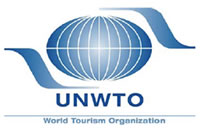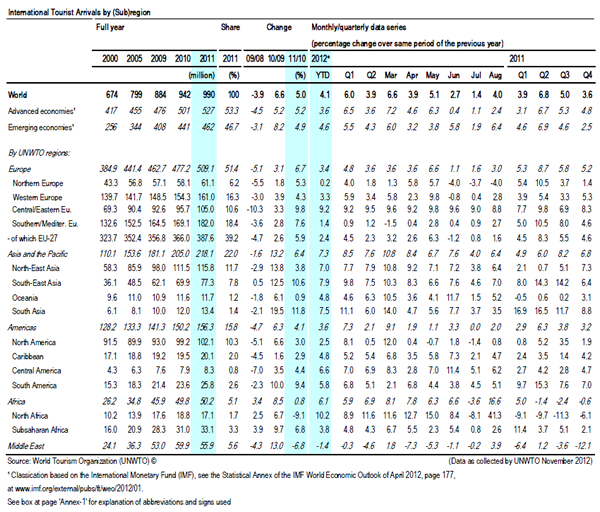 |
INTERNATIONAL. International tourist arrivals grew by +4% between January and August 2012 year-on-year, according to the United Nations World Tourism Organization (UNWTO), although it has predicted a slowdown next year.
The UNWTO’s World Tourism Barometer shows there were a record 705 million international tourists during the period, up 28 million on the same eight months in 2011. UNWTO said it is confident that one billion international tourists will have travelled the world by the end of the year.
Average growth was +5% in the first five months of this year, although it dipped to +2.7% and +1.4% in June and July respectively. However, August, the month that accounts for the highest volume of international tourism in the year, saw a recovery to +4%.
Emerging economies regained the lead in growth, with +5%, compared to advanced economies, with +4%.
The UNWTO is forecasting growth of +3% to +4% for the year as a whole, while a slowdown in demand is expected in 2013, to +2% to +4%.
“This growth is a very positive result in view of the global economic situation,” said UNWTO Secretary-General Taleb Rifai.
“We must remain cautious, however, as we have also observed some weaker months during the year, a trend that might return in the remainder of the year.”
 |
Click on the above to view the enlarged image (then hover over graphs with your cursor and click for full detail) |
Regional growth
By regions, growth was stronger in Asia and the Pacific and Africa, followed by the Americas and Europe. The Middle East continues to show signs of recovery, with particularly promising results in Egypt.
• Europe (+3%) consolidated its record growth of 2011 despite on-going economic volatility in the Eurozone. Results were above average in Central and Eastern Europe (+9%), in line with the average in Western Europe (+3%), yet comparatively weaker in Southern and Mediterranean Europe (+1%) – one of the best performing European sub-regions in 2011 – as well as in Northern Europe (+0.2%).
• South-East Asia and South Asia (both at +8%) led the way in Asia and the Pacific (+7%), followed by North-East Asia (+7%), the latter reflecting the clear recovery of the Japanese inbound and outbound markets. Growth was clearly positive in Oceania (+5%) as compared to the full year 2011 (+1%).
• In the Americas (+4%), Central (+7%) and South America (+6%) continued to show the strongest performances, with growth in the Caribbean (+5%) also significant. International tourist arrivals grew 3% in North America.
• In Africa (+6%), the recovery of Tunisia is clearly reflected in the results of North Africa (+10%), as is the rebound of Egypt in the performance of the Middle East (-1% as compared to a decline of 7% in 2011). Destinations in Sub-Saharan Africa (+4%) continued to show very positive results, consolidating the good growth rates of previous years.
Tourism earnings and expenditures
Among the ten largest international tourism earners, receipts grew significantly during the first six to nine months of 2012 in Hong Kong (China) (+17%), USA (+8%), Germany (+7%), France (+5%) and the UK (+4%). A number of other major destinations reported double-digit growth in receipts, such as Japan (+48%), Sweden (+26%), South Africa (+26%), Republic of Korea (+26%), India (+23%), Poland (+19%), Thailand (+17%), Russian Federation (+16%), Egypt (+13%), Czech Republic (+13%), Taiwan (+11), Singapore (+10%) and Croatia (+10%).
Among the top 10 international markets by expenditure on travel abroad, growth was significant during the first six to nine months of 2012 in China (+30%), Russia (+15%), USA (+9%), Canada (+6%), Germany (+5%), and Australia (+4%) as well as in Japan, where a 7% increase confirms the recovery of this important market.
Following a decline in recent years, the UK recorded a modest 2% growth in tourism expenditure, while both Italy and France showed declines in the level of expenditure on travel abroad.
Other major advanced economies that showed significant growth in expenditure were Austria (+16%), Belgium (+13%), Switzerland (+11%) and Norway (+11%). Among the emerging economies, in addition to China and Russia double-digit growth in expenditure was posted by Poland (+22%), Malaysia (+18%), Argentina (+16%), Philippines (+14%), India (+11%) and Indonesia (+10%).





